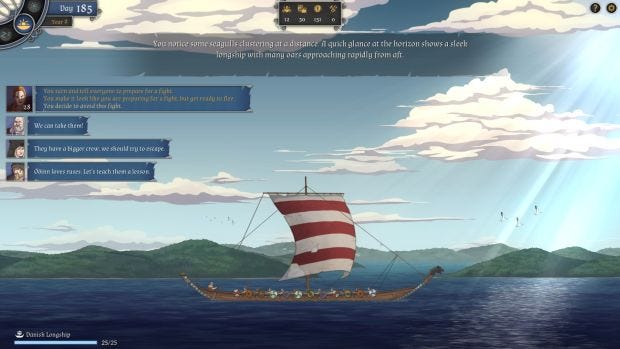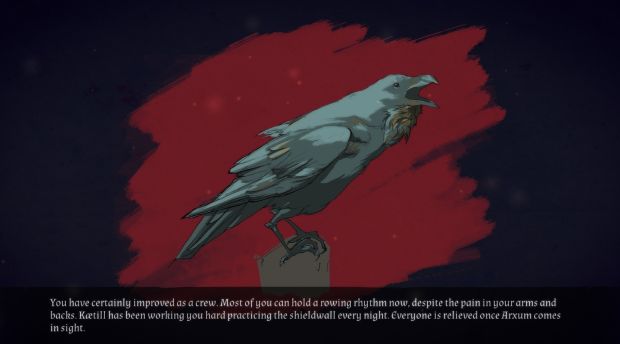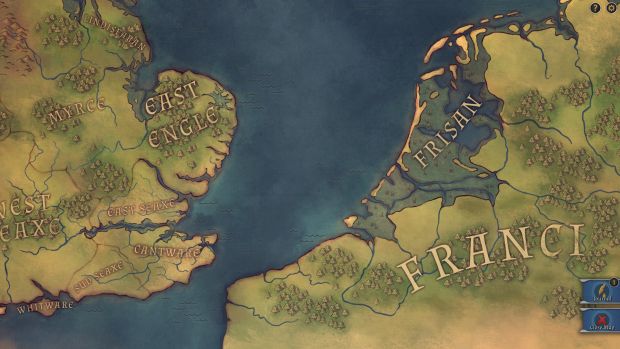Premature Evaluation: The Great Whale Road
Axe time! Sword time! Shields are splintered!
Every Monday we cast Brendan out into the cold seas of early access, in a sodden row boat, armed with nothing but a cheap hunting spear. This week, he has returned with tales of The Great Whale Road.
I sacrificed a dog to Odin today. He wasn’t a very important dog, just some mutt that (according to the lengthy game text) was the mascot of our longship. I didn’t really care when I called him over and cut his throat so that the blood would please the town's priest. To be honest, all I really wanted at this point was to get back on my stinking vessel, go home, and see out the winter. Because, although all of the The Great Whale Road’s battles and questing take place in summer time, it’s the winter that offers the most potential.
You start life in a bumbling island village of Ulfarrsted. You’ve inherited the village after being told (by a very convoluted intro) that the old Jarl is no more. Here you are given a taste of the winter. You have to manage the village by investing focus points in certain things – farming, husbandry, warriors, tradition, crafts. The more you invest, the more you’ll increase your stocks of things like food, fighting men, priests, farmers, trade goods and so on.
Then the winter rolls right through you and prompt after prompt forces you to make decisions about certain events. A man has been gored by a wild boar – do you try to save him or end his suffering? The storehouse roof has collapsed and the oats are getting wet. Do you move what you can, rebuild the roof, or try and dry out the pile with fire? At the end of it all you get a report of how the winter went, how many workers you lost or how much food remains in the stockpiles. It’s like a quickfire round of King of Dragon Pass.
Then the summer comes. In summer you set off with a war band, supposedly looking for trouble but really just following a linear quest to a single destination on your map. Along the way you are attacked by Saxons in ships and Saxons on land and Saxons back in their ships again. And as you sail between fights, even more prompts goad you to make decisions. Dead sharks wash up next to the ship. The water becomes shallow and rocky. Bad luck depletes your resources – food, health, morale. Eventually, you stop at a settlement or campfire or beach market and recuperate your war band by giving them rest and letting them feast in the local tavern. This recharges little meters by their names and gives you a chance to stock up on food for the journey.
Finally, you reach your destination. Well met, Saxon fiends! Let’s have a chat and a feast and then – oh. That’s it. We’re going back home again, a giant ‘Quest complete’ plastered onto the screen. The game automatically brings you all the way back to your home village. Guess where you’re going next summer though? Back the same direction.
Let’s clear something up first. I threw the Banner Saga aside like an old broken hatchet. It took me one hour to get tired of the plodding storyline, the criminally slow trudge through its systems and boring brawls. You can make a game look as beautiful as a classic Disney movie, but if it moves at the pace of a Hungarian art film I am not sticking around for the walk. I’m a patient man when it comes to most games – I somehow enjoy Elite: Dangerous. But when it comes to turn-based strategy games, the computer had better be quick. For me, the Great Whale Road doesn’t repeat the sins of it’s Scandi counterpart. But it does commit whole new ones.
At this moment in its development, it is very samey. The same events will trigger, the same enemies will attack you, and you will fight in the same two environments (a boat and a village). Every settlement offers the same kind of experience – rest, food, feasting and hunting. And every year you do the same trip south, edging only a little further every time. The minute you feel like you are starting to make progress, maybe you have been given a job to do by a priest or a chieftain, suddenly BAM. Back to Ulfarrsted to eke out a winter on all the wheat you forgot to plant.
I think this is more a matter of disappointment than anything else. The game starts so strongly. Here’s your warriors, here’s your village. Now let’s go and plunder. But none of the systems are fully there yet. Underneath that beautiful cartoon art, everything is skeletal.
Take the fighting system, for instance. The ideas behind this are strong. When you get into a fight, everything becomes a hexagonal tabletop grid with two little figurines on top. It’s your leader versus theirs. You get three cards dealt to you. Some of these might be red character cards, others blue “action” cards. Red cards introduce new warriors to the battlefield. Up to three warriors come along with you. You can shuffle any cards you don’t want to use back into your hand, so the beginning of a battle is often a desperate mulligan to see if you can find any of your clansmen to bring into the fight.
These warriors might be heavies, assaults or support. Heavies have a high defence rating and can take more hits before losing HP. Assaults are efficient attackers that cause more damage and debilitating effects like bleeding, which drains HP slowly, or broken limbs, which limits enemy movement on the grid. Everyone can move two spaces at a time before either attacking or putting their shield up for an extra defence point. The actual business of standing beside someone and attacking is a bit of a mess of luck and numbers. But basically a high defence means strikes will graze off without real damage. A high attack means when you hit, you’ll hit harder. That’s where the blue action cards come in – you can use these to increase defence and attack stats of your men. It is all hilariously board gamey. But it works.
Or at least, it ought to. Sadly, the sameyness that affects the seafaring portion of the game also invades the battles. Mostly, this comes down to a lack of cards. After my fourth year of battling and sailing, I still hadn’t received any new cards. I started to notice that many of the cards did the same things, but were simply adorned with different names, as if that would bring some variety to the fighting. Mechanically, it makes little difference if I use the ‘Wedge’ card or ‘Cautious Move’ card, because both of them increase defence of a character by 2. Likewise, the ‘Blind Fury’ card and ‘Veteran Warrior’ card are effectively identical – both increase attack by 2. The only difference between these cards is who they apply to – one might be for an assault class like Bera, another for heavies like Hild, and others for any ally at all. In the heat of a fight this makes little noticeable difference, and cards that should be distinct end up feeling exactly the same.
It wouldn’t be so bad if after every fight you were awarded some of your opponents cards – something new to incorporate. But as it stands you do the same thing in every battle. Shuffle through looking for warriors, playing all your reds, forming into a “wall”, and waiting for the baddies to fall into you. This is a pity. The battle system itself isn’t broken – it’s just that the cards are so few and what cards there are lack imagination.
Here’s an example. There’s a card called Shield Wall. “Now we’re talking,” I thought when I saw this card’s name. “I’ve seen Vikings on the History channel. I know how cool shield walls are.” Then I read the effect the card gave. + 3 defence. What! Why doesn’t this card raise the defence of everyone adjacent to a character? Something that would actually form a shield wall. Maybe this card is meant to do that in the future, but that makes you wonder, why include it at all? As a placeholder it’s just a slightly better version of other cards. The card system is like the people back in your home village – undernourished. I'm glad to read in their roadmap that the combat is planned for an overhaul in October, because to run out of enthusiasm for the fights after a couple of hours is disappointing. For any future turn-based strategy developers thinking of taking the great early access road - get your combat absolutely nailed first. Then fill out the rest.
It doesn’t help that there are no rewards for winning a fight (apart from your ship being magically repaired). I began my reign by seeking out fights because all my best warriors had a “brave” personality trait and I figured they’d be warlike folks. I would stomp into villages (if the game allowed me) and start fights with people who looked at me wrong. But after dealing out the same old card-scripted combat again and again I began to avoid fights, not because they posed a threat, but because they weren’t interesting and there was absolutely nothing in it for me. This is a story about raiding and pillaging, where are the spoils? I suspect you’ll be given more gear, loot or food in future updates but it really feels like that should have been a core inclusion upon its appearance in early access.
In fact, an awful lot about the Whale Road makes it feel like it is only a shadowy plan of things to come. All the imagery is there, the atmosphere and the vision. And what a vision. Just look at this map.
I long to be able to go on raids and harass those dirty Christians in Wessex and get my warriors killed over an inconsequential argument in a tavern. I love that stuff. I’ve read a paragraph from the Poetic Edda, you know. I’ve fallen asleep to an audiobook of Beowulf. I am DOWN TO RUCKUS. But it looks like I’ll have to wait, sadly. All the scaffolding for this game exists. But the game itself? It’s nowhere to be seen. Maybe after the long winter.
The Great Whale Road is available on Steam for £10.99/$14.99. These impressions were based on build 1252460











